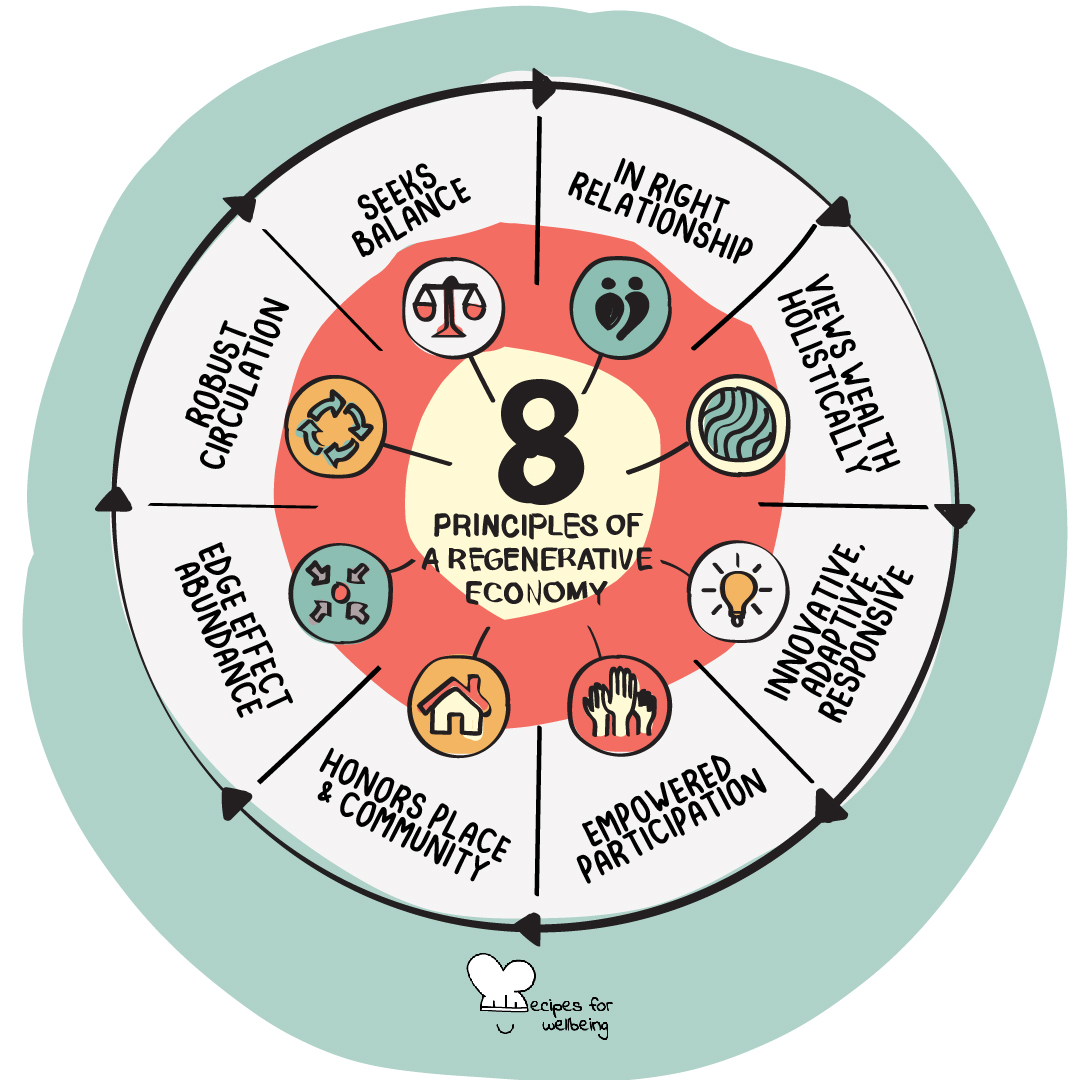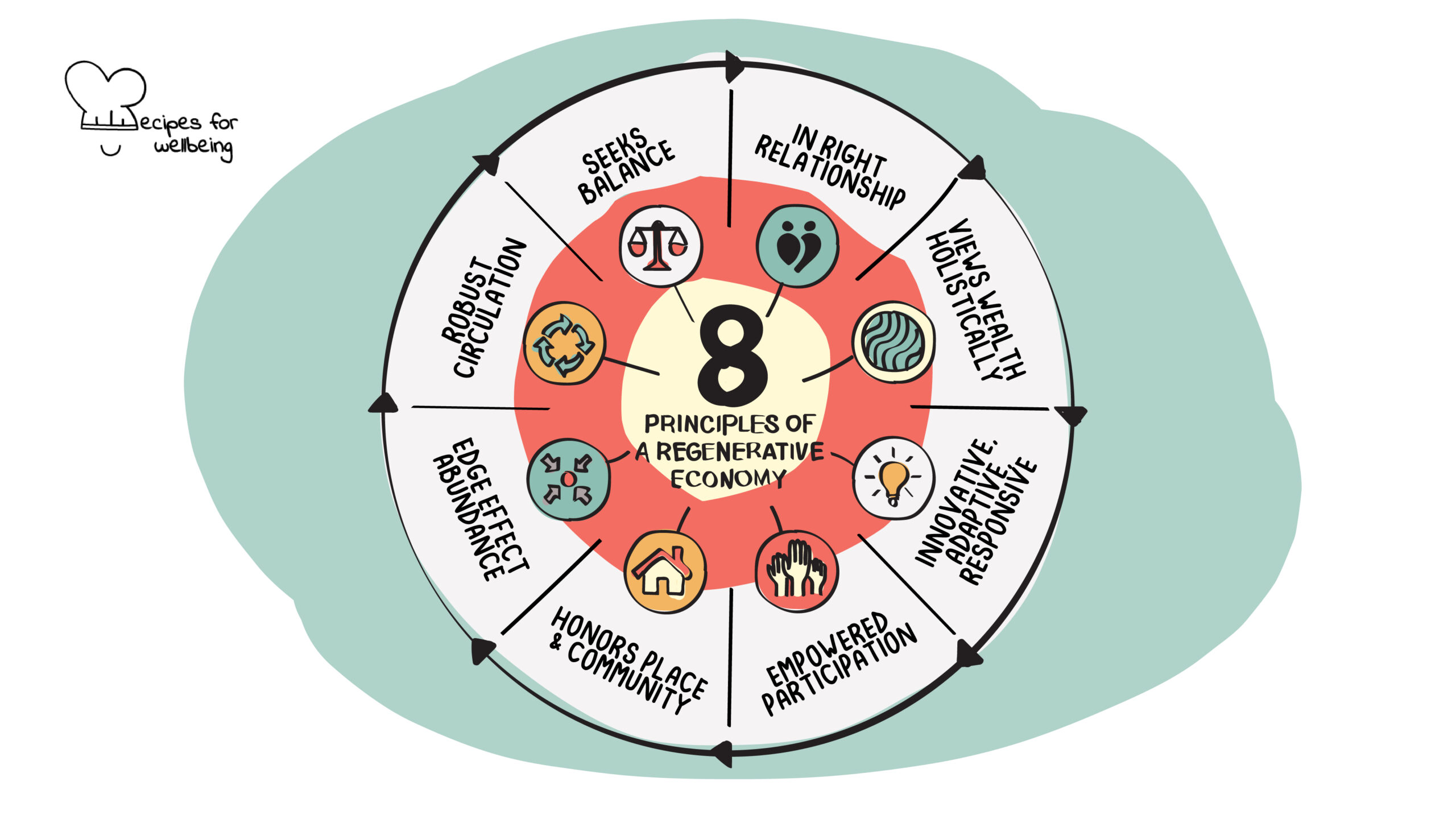
Regenerative Economy
The true nature of the international (economic) system under which we were living was not realised until it failed. ―Karl Polanyi
👥 Serves: No limits of people
🎚 Difficulty: Hard
⏳ Total time: Ongoing
🥣 Ingredients: Grit, determination and dedication to sustainability
💪 Nutritional values: Sustainability, Growth, Development, Prosperity, Connectedness

Regenerative Economy
📝 Description
Implore the principles of a Regenerative Economy.
The dominant economic model is unsustainable. Why? Because it focuses greatly on financial prosperity, with an accumulation of money as the only measure of wealth and success – without much thought as to how growth can negatively impact both people and the planet. Global trends point to high unemployment rates, particularly among young people, burgeoning poverty, and widening inequality, paired with the cascading environmental crises, notably climate change.
It all sounds very doom and gloom. But does it have to be?
According to the unconventional economist, impact investor, writer, and philosopher, John Fullerton, it is time for humans to embrace the Regenerative Economy, an emerging economy model that regards the economy as a living system because humans and the planet are too a living system. Such a model is based around an economy which regenerates resources used and repairs previous damage. The characteristics of a Regenerative Economy are:
- It acts in ways that support the long-term health of the entire society.
- It sees economic and financial health as inseparable from human, societal, and environmental health.
- It values richness and diversity, integrity, and fairness, and seeks excellence through constructive competition.
- It responds to the full gamut of human needs, continuously adapting to changing circumstances, and evolving to higher and more effective levels of the organisation.
The Regenerative Economy is a proponent of the idea that “natural systems thrive because they are regenerative”, and that when something is built in a regenerative manner, including an economic system, it inherently becomes sustainable. The goal is for businesses, finances, and policymakers to shift towards regenerative principles to give rise to healthy human networks.
This recipe has been created by our wellbeing content writer collaborator Marissa Del Mistro and has been adapted by the work of John Fullerton.
👣 Steps
Step 1 – Understanding the principles of Regenerative Economy
Regenerative Economics believes that since humans are living beings, so should the economy be embedded as a living system. As such, the following 8 key, interconnected principles were created:
- Right relationship: Humanity is an integral part of an interconnected life with no separation between “us” and “it”, with ‘it’ being the natural world and each other through synergistic collaboration. If we think of the world as one system, we can see and understand how societies and the biosphere rely on each other so greatly and if one is damaged, so too is the other, including the financial system.
- Viewing wealth holistically: True wealth cannot be defined as an abundance of money in a bank account. It must instead be defined and managed in terms of the wellbeing of the whole, including social, cultural, living, and experiential terms. For example, upon meeting the basic human needs of financial and material capital, the remaining money should be distributed to things such as social capital in the community or to restoring natural capital for true abundance.
- Innovative, adaptive, responsive: The qualities of innovation and adaptability are critical to this economic model. The idea is that we as a whole must be not only open to change but adaptable to a changing environment.
- Empowered participation: The quality of empowered participation means that as an interconnected system, everyone matters, and the health of the economy is dependent on people being actively engaged in ways that not only empower them to negotiate for their needs but enable them to make unique contributions based on abilities/skills.
- Honours community and place: A Regenerative Economy respects diversity proudly by honouring differences in communities and regions, as they each offer a unique role based on their individual history and place.
- Edge effect abundance: Creativity and abundance should be cultivated from people and the land through collaborative working, learning and development. Rather than separate people and groups, the idea would be to bring together forces such as private, public, NGO, philanthropic and different socio-economic groups to a common goal and purpose.
- Robust circulatory flow: Economic health depends on robust circulatory flows of money, information, resources, goods, and services to support exchange, remove negative and nourish every level of the human network. The circulation of money and information and the efficient use and reuse of materials are particularly critical to individuals, businesses, and economies reaching their regenerative potential.
- Seeks balance: To be a regenerative economic system, economic sectors will need to shift to a more decentralised model to restore balance and create a healthy system. There is a call as well to find a balance between efficiency and resilience; collaboration and competition; diversity and coherence; and small, medium, and large organisations and needs.
Step 2 – 6 ways to participate in Regenerative Economy
- Start or support social entrepreneurship or for-benefit enterprises. A social entrepreneur would seek opportunities that can bring a positive impact to their community, society, or world. The people take a 360° wide approach with a social and environmental purpose at the core of their endeavour(s) and operate by putting people and the planet first.
- Focus on slow living. Focus on the preservation of your local food cultures and traditions as well as educating and informing others about the food they eat, where it comes from and how our food choices affect the world around us. Slower living can impact community development and connectedness, strengthen the economy, help alleviate food security and improve conditions while sharing resources. Consult Slow Food International to learn more.
- Ensure your investments are impactful. Impact investment is the idea that any money invested into organisations or funds by families, individuals or organisations is done so after getting them to generate a measurable, beneficial social or environmental impact in addition to a financial return.
- Start or donate to non-profit organisations. Non-profit organisations (NGOs) are often created by ordinary citizens and run by volunteers or funded by foundations, private persons, or governments, devoted to important issues that require long term support. Starting a non-profit is a tangible way to give back to the community, and the wider world and ensure it is done sustainably.
- Start or shop at co-ops. There are many cooperative (co-op) models such as nursery schools, cleaning, consulting, delivery, housing, and groceries. As food co-op like grocery stores are very popular, it is a member-owners co-op whereby the purchase of shares in the co-op. These member-owners have a huge say in how the cooperative is run, its purchasing practices, and what it stocks. Food co-ops are rooted in the communities they serve, creating a sense of sustainable accountability among the workers, members, and shoppers. Rather than being a one-way commercial exchange of goods for money, the people who shop at co-ops are participating in a system that is committed to community development. The majority of these food co-ops are involved in community education projects and other enrichment activities.
- Lobby for car-free areas. Creating long-term car-free zones in the city can decrease pollution while increasing socialising, community building and healthy living. Often, an agreement can be made for a long period (10+ years) which is when the impact is most beneficial.
Step 3 – Inspiration for a future with Regenerative Economy
It is worth noting that John Fullerton himself explained how challenging starting a regenerative economy is. It involves an immense overhaul of the current economic frameworks and must be embedded by corporations and governments for it to be a success. While step 2 highlights tangible ways for you to get on board, here are some larger-scale projects that saw success using Regenerative Economy principles for you to hopefully get inspired!
- The Evergreen Cooperatives based in Cleveland, Ohio, USA, have created a grassroots solution to the crisis of poverty in inner cities by developing a network of locally anchored, worker-owned businesses to generate jobs and greater local empowerment and wealth-building. Evergreen Cooperatives has grown Evergreen Energy Solutions, Evergreen Cooperative Laundry, and Green City Growers Cooperative.
- Detroit Kitchen Connect based in Detroit, Michigan, USA, is a kitchen incubator that is finding creative ways to use underutilised resources to forge closer social relationships, bringing people together who might not otherwise connect through the shared love of food. Together with local partners, they are making kitchens more accessible and turning neighbourhoods into food entrepreneurship hubs.
- Grasslands, LLC based in Bozeman, Montana USA created a “custom grazing” business which expanded to ranches in South Dakota, Montana, Hawaii, Florida, and New Zealand. The model uses holistic-management practices to regenerate overgrazed land, increasing its biodiversity, water retention, soil quality, and carbon sequestering ability while also harnessing financial, human, and ecological capital.
- Grupo Ecológico based in Sierra Gordo, Mexico is a not-for-profit collaborative that created the only locally governed Biosphere Reserve in Mexico, while putting in place a variety of innovative funding to empower a network of impoverished farmers and ranchers to take on jobs as regenerators of their homelands.
- The Bendigo Community Bank Model based in Australia, with over 300 branches, is a unique banking framework where the bank partners with local communities, requiring them to make an initial upfront investment in a branch operation while the bank takes on full responsibility for staff training, IT, products, capital, and regulatory and compliance issues. Net income is then split between Bendigo Bank and the local community enterprise. What’s more, a portion of the earnings is directed toward local grantmaking. The model has helped recirculate the flow of financial capital into local economies in meaningful, self-directed ways, and is giving local leaders the business acumen to become active players in their communities’ economic transitions.

